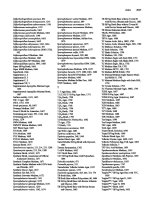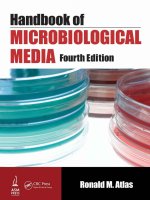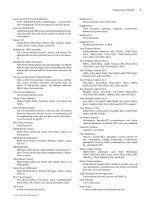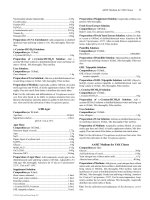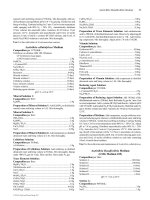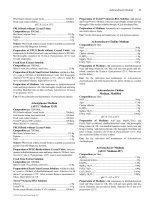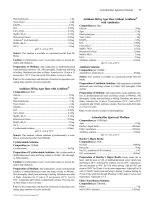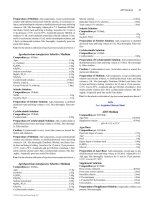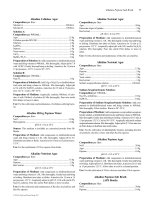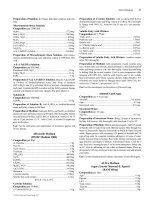Handbook of Microbiological Media, Fourth Edition part 69 potx
Bạn đang xem bản rút gọn của tài liệu. Xem và tải ngay bản đầy đủ của tài liệu tại đây (235.77 KB, 10 trang )
Ferrous Sulfate/Yeast Extract Medium 675
Vitamin Solution:
Composition
per liter:
Pyridoxine-HCl 10.0mg
Thiamine-HCl·2H
2
O 5.0mg
Riboflavin 5.0mg
Nicotinic acid 5.0mg
D-Ca-pantothenate 5.0mg
p-Aminobenzoic acid 5.0mg
Lipoic acid 5.0mg
Biotin 2.0mg
Folic acid 2.0mg
Vitamin B
12
0.1mg
Preparation of Vitamin Solution: Add components to distilled/
deionized water and bring volume to 1.0L. Mix thoroughly. Sparge
with 80% H
2
+ 20% CO
2
. Filter sterilize.
Na
2
S·9H
2
O Solution:
Composition per 10.0mL:
Na
2
S·9H
2
O 0.5g
Preparation of Na
2
S·9H
2
O Solution: Add Na
2
S·9H
2
O to dis-
tilled/deionized water and bring volume to 10.0mL. Sparge with N
2
.
Autoclave for 15 min at 15 psi pressure–121°C. Cool to 25°C. Store an-
aerobically.
Preparation of Medium: Add components, except Na
2
S·9H
2
O so-
lution, vitamin solution, and Na-pyruvate solution, to distilled/deion-
ized water and bring volume to 990.0mL. Mix thoroughly. Flush
medium with N
2
for 20 min. Adjust medium pH to 7.0 with 4N H
2
SO
4
.
Add 10.0mL of
Na
2
S·9H
2
O solution. Mix thoroughly. Readjust the
medium pH to 7.0 with H
2
SO
4
, while flushing the gas phase only with
N
2
. Dispense 10mL volumes into 100mL serum bottles with rubber
stoppers under N
2
. Replace gas phase by 80% H
2
+ 20% CO
2
gas mix-
ture and finally pressurize the bottles to 2 bar gas overpressure. Auto-
clave for 15 min at 15 psi pressure–121°C. Aseptically inject via syringe
0.1mL vitamin solution and 0.1mL Na-pyruvate solution into each tube
containing 10.0mL of the autoclaved medium.
Use: For the cultivation of Ferroglobus placidus.
Ferroplasma acidiphilum Medium
(DSMZ Medium 874)
Composition per 1001.6mL:
Solution A 950.0mL
Solution B 10.0mL
Solution C 1.6mL
pH 1.7 ± 0.2 at 25°C
Solution A:
Composition
per 950.0mL:
MgSO
4
·7H
2
O 0.4g
(NH
4
)
2
SO
4
0.2g
KCl 0.1g
K
2
HPO
4
0.1g
Preparation of Solution A: Add components to distilled/deionized
water and bring volume to 950.0mL. Mix thoroughly.
Solution B:
Composition
per 50.0mL:
FeSO
4
·7H
2
O 25.0g
H
2
SO
4
, 1N 40.0mL
Preparation of Solution B: Add components to distilled/deionized
water and bring volume to 50.0mL. Mix thoroughly.
Solution C:
Composition
per 10.0mL:
Yeast extract 1.0g
Preparation of Solution C: Add yeast extract to distilled/deionized
water and bring volume to 10.0mL. Mix thoroughly. Autoclave for 15
min at 15 psi pressure–121°C. Cool to 25°C.
Preparation of Medium: Add 50.0mL solution B to 950.0mL so-
lution A. Mix thoroughly. Adjust pH to 1.6–1.8 with H
2
SO
4
. Filter ster-
ilize. Aseptically add 1.6 mL of sterile solution C. Pour into sterile
Petri dishes or leave in tubes. Mix thoroughly. Aseptically distribute to
sterile tubes or flasks.
Use: For the cultivation of Ferroplasma acidiphilum (Ferriplasma aci-
dophilum).
Ferrous Sulfate/Yeast Extract Medium
(DSMZ Medium 1190)
Composition per liter:
Yeast extract 0.2g
Basal salts solution 20.0mL
Ferrous sulfate solution 20.0mL
Trace elements solution 1.0mL
Basal Salts Solution:
Composition
per liter:
MgSO
4
·7H
2
O 25.0g
(NH
4
)
2
SO
4
22.5g
Na
2
SO
4
·10H
2
O 7.5g
KCl 2.5g
KH
2
PO
4
2.5g
Ca(NO
3
)·4H
2
O 0.7g
Preparation of Basal Salts Solution: Add components to dis-
tilled/deionized water and bring volume to 1.0L. Mix thoroughly. Au-
toclave for 15 min at 15 psi pressure–121°C.
Trace Elements Solution:
Composition
per liter:
ZnSO
4
·7H
2
O 10.0g
CuSO
4
·5H
2
O 1.0g
CoO
4
·7H
2
O 1.0g
MnSO
4
·2H
2
O 1.0g
NiSO
4
·6H
2
O 1.0g
Na
2
SeO
4
1.0g
Na
2
WO
4
·2H
2
O 1.0g
Cr
2
(SO
4
)
3
·15H
2
O 0.5g
H
3
BO
3
0.6g
Na
2
MoO
4
·2H
2
O 0.5g
NaVO
3
0.1g
Preparation of Trace Elements Solution: Adjust pH of 800.0mL
of distilled/deionized water to 2.0 with dilute H
2
SO
4
. Add the above
salts in order one at a time, allowing each to dissolve before adding the
next. Maintain the pH at 2.0 by adding H
2
SO
4
as necessary. After ad-
dition of vanadate, bring volume to 1.0L with water. Adjust final pH to
2.0. Autoclave for 15 min at 15 psi pressure–121°C. The vanadate will
require several days to dissolve.
Ferrous Sulfate Solution:
Composition
per 20.0mL:
FeSO
4
·7H
2
O 2.78g
Preparation of Ferrous Sulfate Solution: Adjust pH of 20.0mL
of distilled/deionized water to 1.8 with H
2
SO
4
. Add FeSO
4
·7H
2
O. Mix
thoroughly. Filter sterilize.
© 2010 by Taylor and Francis Group, LLC
676 Ferrous Sulfide Agar
Preparation of Medium: Add components, except ferrous sulfate
solution, to distilled/deionized water and bring volume to 980.0mL.
Mix thoroughly. Adjust pH to 2.0 with H
2
SO
4
. Gently heat while stir-
ring and bring to boiling. Boil for 1 min. Autoclave for 20 min at 15 psi
pressure–121°C. Cool to room temperature. Aseptically add the fer-
rous sulfate solution.
Use: For the cultivation of Sulfobacillus spp.
Ferrous Sulfide Agar
Composition per 1200.0mL:
Agar layer 1.0L
Liquid overlay 200.0mL
Agar Layer:
Composition per liter:
Agar 30.0g
FeS washed precipitate supension 500.0mL
Preparation of Agar Layer: Add agar to distilled/deionized water
and bring volume to 500.0mL. Mix thoroughly. Gently heat and bring to
boiling. Autoclave for 15 min at 15 psi pressure–121°C. Cool to 45°–
50°C. Heat FeS washed precipitate suspension to 45°–50°C. Mix thor-
oughly. Aseptically add 500.0mL of sterile FeS washed precipitate supen-
sion to 500.0mL of sterile agar at 45°–50°C. Mix thoroughly.
FeS Washed Precipitate Suspension:
Composition per 500.0mL:
Fe(NH
4
)
2
(SO
4
)
2
·6H
2
O 78.4g
Na
2
S·9H
2
O 15.6g
Preparation of FeS Washed Precipitate Suspension: Add
Na
2
S·9H
2
O and Fe(NH
4
)
2
(SO
4
)
2
·6H
2
O to 500.0mL boiling distilled/
deionized water. Let precipitate settle from the hot solution in a com-
pletely filled and stoppered bottle. Wash precipitate four times by de-
canting supernatant and replacing each time with 500.0mL of boiling
distilled/deionized water. Store FeS washed precipitate suspension in a
completely filled 500.0mL glass-stoppered bottle.
Liquid Overlay:
Composition per liter:
(NH
4
)
2
Cl 1.0g
K
2
HPO
4
0.5g
MgSO
4
·7H
2
O 0.2g
CaCl
2
0.1g
Preparation of Liquid Overlay: Add components to distilled/de-
ionized water and bring volume to 1.0L. Mix thoroughly. Autoclave for
15 min at 15 psi pressure–121°C. Cool to 25°C. Aseptically bubble
100% CO
2
for 15 sec.
Preparation of Medium: Aseptically distribute agar layer into ster-
ile tubes in 10.0mL volumes. Allow tubes to cool in a slanted poistion.
Aseptically add 2.0mL of sterile liquid overlay to each tube.
Use: For the enumeration, enrichment, and isolation of iron and sulfur
bacteria, including Gallionella ferruginea.
Ferulate Medium
Composition per 1016.0mL:
Solution A 916.0mL
Solution B 70.0mL
Solution C 10.0mL
Solution D 10.0mL
Solution E 10.0mL
pH 7.2 ± 0.2 at 25°C
Solution A:
Composition
per 916.0mL:
Pancreatic digest of casein 1.0g
Resazurin 1.0mg
Mineral solution 50.0mL
Rumen fluid, clarified 50.0mL
Vitamin solution 5.0mL
Trace elements solution SL-10 1.0mL
Mineral Solution:
Composition
per liter:
Nitrilotriacetic acid 12.5g
NaCl 1.0g
FeCl
3
·4H
2
O 0.2g
MnCl
2
·4H
2
O 0.1g
CaCl
2
·2H
2
O 0.1g
ZnCl
2
0.1g
CuCl
2
0.02g
Na
2
SeO
3
0.02g
CoCl
2
·6H
2
O 0.017g
H
3
BO
3
0.01g
Na
2
MoO
4
·2H
2
O 0.01g
Preparation of Mineral Solution: Add nitrilotriacetic acid to
500.0mL of distilled/deionized water. Adjust pH to 6.5 with KOH. Add
remaining components. Add distilled/deionized water to 1.0L. Mix
thoroughly.
Vitamin Solution:
Composition
per liter:
Nicotinic acid 2.5mg
Thiamine·HCl 1.25mg
p-Aminobenzoic acid 1.25mg
Pantothenic acid 0.62mg
Pyridoxine·HCl 6.2mg
Biotin 0.25mg
Preparation of Vitamin Solution: Add components to distilled/
deionized water and bring volume to 1.0L. Mix thoroughly.
Trace Elements Solution SL-10:
Composition
per liter:
FeCl
2
·4H
2
O 1.5g
CoCl
2
·6H
2
O 190.0mg
MnCl
2
·4H
2
O 100.0mg
ZnCl
2
70.0mg
Na
2
MoO
4
·2H
2
O 36.0mg
NiCl
2
·6H
2
O 24.0mg
H
3
BO
3
6.0mg
CuCl
2
·2H
2
O 2.0mg
HCl (25% solution) 10.0mL
Preparation of Trace Elements Solution SL-10: Add FeCl
2
·4H
2
O
to 10.0mL of HCl solution. Mix thoroughly. Add distilled/deionized
water and bring volume to 1.0L. Add remaining components. Mix thor-
oughly.
Preparation of Solution A: Add components to distilled/deionized
water and bring volume to 916.0mL. Adjust pH to 7.2. Gently heat and
bring to boiling. Continue boiling for a few minutes. Allow to cool to
room temperature under 80% N
2
+ 20% CO
2
. Distribute into bottles
under 80% N
2
+ 20% CO
2
. Autoclave for 15 min at 15 psi pressure–
121°C.
Solution B:
Composition
per 70.0mL:
NaHCO
3
3.5g
© 2010 by Taylor and Francis Group, LLC
Fervidobacterium Medium 677
Preparation of Solution B: Add NaHCO
3
to distilled/deionized
water and bring volume to 70.0mL. Mix thoroughly. Filter sterilize.
Sparge with 80% N
2
+ 20% CO
2
for 15 min.
Solution C:
Composition
per 10.0mL:
L-Cysteine·HCl 0.3g
Preparation of Solution C: Add L-cysteine·HCl to distilled/deion-
ized water and bring volume to 10.0mL. Mix thoroughly. Sparge with
100% N
2
for 3–4 min. Autoclave under 100% N
2
for 15 min at 15 psi
pressure–121°C.
Solution D:
Composition
per 10.0mL:
Na
2
S·9H
2
O 0.3g
Preparation of Solution D: Add Na
2
S·9H
2
O to distilled/deionized
water and bring volume to 10.0mL. Mix thoroughly. Sparge with 100%
N
2
for 3–4 min. Autoclave under 100% N
2
for 15 min at 15 psi pres-
sure–121°C.
Solution E:
Composition
per 10.0mL:
Sodium ferulate 1.5g
Preparation of Solution E: Add sodium ferulate to distilled/deion-
ized water and bring volume to 10.0mL. Mix thoroughly. Filter steril-
ize. Sparge with 100% N
2
for 3–4 min.
Preparation of Medium: To 916.0mL of sterile solution A, add
70.0mL of sterile solution B, 10.0mL of sterile solution C, 10.0mL of
sterile solution D, and 10.0mL of sterile solution E. Mix thoroughly.
Anaerobically and aseptically distribute into sterile tubes or flasks.
Use: For the cultivation and maintenance of Eubacterium callanderi.
Fervidobacterium islandicum Medium
Composition per liter:
(NH
4
)
2
SO
4
1.3g
Yeast extract 1.0g
KH
2
PO
4
0.28g
MgSO
4
·7H
2
O 0.25g
CaCl
2
·2H
2
O 0.07g
FeCl
3
·6H
2
O 0.02g
Na
2
B
4
·10H
2
O 4.5mg
MnCl
2
·4H
2
O 1.8mg
Resazurin 1.0mg
ZnSO
4
·7H
2
O 0.22mg
CuCl
2
·2H
2
O 0.05mg
Na
2
MoO
4
·2H
2
O 0.03mg
VOSO
4
·2H
2
O 0.03mg
CoSO
4
0.01mg
Glucose solution 20.0mL
Na
2
S·9H
2
O solution 10.0mL
pH 7.0 ± 0.2 at 25°C
Glucose Solution:
Composition
per 20.0mL:
Glucose 2.0g
Preparation of Glucose Solution: Add glucose to distilled/deion-
ized water and bring volume to 20.0mL. Mix thoroughly. Sparge with
100% N
2
for 3–4 min. Autoclave for 15 min at 15 psi pressure–121°C.
Na
2
S·9H
2
O Solution:
Composition
per 10.0mL:
Na
2
S·9H
2
O 0.5g
Preparation of Na
2
S·9H
2
O Solution: Add Na
2
S·9H
2
O to dis-
tilled/deionized water and bring volume to 10.0mL. Mix thoroughly.
Gas under 100% N
2
. Autoclave for 15 min at 15 psi pressure–121°C.
Preparation of Medium: Add components, except glucose solu-
tion and Na
2
S·9H
2
O solution, to distilled/deionized water and bring
volume to 970.0mL. Mix thoroughly. Adjust pH to 7.0. Sparge with
100% N
2
. Autoclave for 15 min at 15 psi pressure–121°C. Aseptically
and anaerobically add 20.0mL of sterile glucose solution and 10.0mL
of sterile Na
2
S·9H
2
O solution. Mix thoroughly.
Use: For the cultivation of Fervidobacterium islandicum.
Fervidobacterium Medium
Composition per liter:
Pancreatic digest of casein 10.0g
Glucose 5.0g
Yeast extract 3.0g
K
2
HPO
4
1.5g
NH
4
Cl 0.9g
KH
2
PO
4
0.75g
MgCl
2
·6H
2
O 0.2g
Na
2
S·9H
2
O solution 10.0mL
Trace elements solution 9.0mL
Wolfe’s vitamin solution 5.0mL
Resazurin (0.2% solution) 1.0mL
FeSO
4
·7H
2
O (10% solution) 0.03mL
pH 7.0 ± 0.1 at 25°C
Trace Elements Solution:
Composition
per liter:
Nitrilotriacetic acid 12.5g
NaCl 1.0g
FeCl
3
·4H
2
O 0.2g
CaCl
2
·2H
2
O 0.1g
MnCl
2
·4H
2
O 0.1g
ZnCl
2
0.1g
CuCl
2
0.02g
Na
2
SeO
3
0.02g
CoCl
2
·6H
2
O 0.017g
H
3
BO
3
0.01g
Na
2
MoO
4
·2H
2
O 0.01g
Preparation of Trace Elements Solution: Add nitrilotriacetic
acid to 500.0mL of distilled/deionized water. Dissolve by adjusting pH
to 6.5 with KOH. Add remaining components. Add distilled/deionized
water to 1.0L. Filter sterilize. Maintain under an atmosphere of 100%
N
2
.
Wolfe’s Vitamin Solution:
Composition per liter:
Pyridoxine·HCl 0.01g
Thiamine·HCl 5.0mg
Riboflavin 5.0mg
Nicotinic acid 5.0mg
Calcium pantothenate 5.0mg
p-Aminobenzoic acid 5.0mg
Thioctic acid 5.0mg
Biotin 2.0mg
Folic acid 2.0mg
Cyanocobalamin 0.1mg
Preparation of Wolfe’s Vitamin Solution: Add components to
distilled/deionized water and bring volume to 1.0L. Mix thoroughly.
Filter sterilize. Maintain under an atmosphere of 100% N
2
.
© 2010 by Taylor and Francis Group, LLC
678 F-G Agar
Na
2
S·9H
2
O Solution:
Composition per 10.0mL:
Na
2
S·9H
2
O 0.5g
Preparation of Na
2
S·9H
2
O Solution: Add Na
2
S·9H
2
O to dis-
tilled/deionized water and bring volume to 10.0mL. Mix thoroughly.
Filter sterilize. Maintain under an atmosphere of 100% N
2
.
Preparation of Medium: Add components, except sodium sulfide
solution, trace elements solution, and Wolfe’s vitamin solution, to dis-
tilled/deionized water and bring volume to 976.0mL. Mix thoroughly.
Autoclave for 15 min at 15 psi pressure–121°C. Cool under an atmo-
sphere of 100% N
2
. Aseptically add 9.0mL of trace elements solution
and 5.0mL of Wolfe’s vitamin solution under an atmosphere of 100%
N
2
. Mix thoroughly. Aseptically distribute into sterile tubes or flasks
under an atmosphere of 100% N
2
. Add Na
2
S·9H
2
O solution just prior
to use to a concentration of 0.1%.
Use: For the cultivation and maintenance of Clostridium species, Fer-
vidobacterium nodosum, Fervidobacterium islandicum, and Thermoa-
naerobium brockii.
F-G Agar
(Feeley-Gorman Agar)
Composition per liter:
Casein, acid hydrolyzed 17.5g
Agar 17.0g
Beef extract 3.0g
Starch 1.5g
L-Cysteine solution 10.0mL
Fe
4
(P
2
O
7
)
3
solution 10.0mL
pH 6.9 ± 0.05 at 25°C
L-Cysteine Solution:
Composition per 10.0mL:
L-Cysteine·HCl·H
2
O 0.4g
Preparation of L-Cysteine Solution: Add L-cysteine·HCl·H
2
O to
distilled/deionized water and bring volume to 10.0mL. Mix thorough-
ly. Filter sterilize.
Fe
4
(P
2
O
7
)
3
Solution:
Composition per 10.0mL:
Fe
4
(P
2
O
7
)
3
0.25g
Preparation of Fe
4
(P
2
O
7
)
3
Solution: Add Fe
4
(P
2
O
7
)
3
to distilled/
deionized water and bring volume to 10.0mL. Mix thoroughly. Filter
sterilize.
Preparation of Medium: Add components, except L-cysteine solu-
tion and Fe
4
(P
2
O
7
)
3
solution, to distilled/deionized water and bring
volume to 980.0mL. Mix thoroughly. Gently heat and bring to boiling.
Autoclave for 15 min at 15 psi pressure–121°C. Cool to 45°–50°C.
Aseptically add 10.0mL of
L-cysteine solution. Mix thoroughly. Asep-
tically add 10.0mL of Fe
4
(P
2
O
7
)
3
solution. Mix thoroughly. Adjust pH
to 6.9. Pour into sterile Petri dishes or distribute into sterile tubes.
Use: For the isolation and cultivation of Legionella pneumophila.
F-G Agar with Selenium
(Feeley-Gorman Agar with Selenium)
Composition per liter:
Casein, acid hydrolyzed 17.5g
Agar 17.0g
Beef extract 3.0g
Starch 1.5g
L-Cysteine solution 10.0mL
Fe
4
(P
2
O
7
)
3
solution 10.0mL
Na
2
SeO
3
·5H
2
O solution 10.0mL
pH 6.9 ± 0.05 at 25°C
L-Cysteine Solution:
Composition per 10.0mL:
L-Cysteine·HCl·H
2
O 0.4g
Preparation of L-Cysteine Solution: Add L-cysteine·HCl·H
2
O to
distilled/deionized water and bring volume to 10.0mL. Mix thorough-
ly. Filter sterilize.
Fe
4
(P
2
O
7
)
3
Solution:
Composition per 10.0mL:
Fe
4
(P
2
O
7
)
3
0.25g
Preparation of Fe
4
(P
2
O
7
)
3
Solution: Add Fe
4
(P
2
O
7
)
3
to distilled/
deionized water and bring volume to 10.0mL. Mix thoroughly. Filter
sterilize.
Na
2
SeO
3
·5H
2
O Solution:
Composition per 10.0mL:
Na
2
SeO
3
·5H
2
O 0.01g
Preparation of Na
2
SeO
3
·5H
2
O Solution: Add Na
2
SeO
3
·5H
2
O to
distilled/deionized water and bring volume to 10.0mL. Mix thorough-
ly. Filter sterilize.
Preparation of Medium: Add components—except L-cysteine so-
lution, Fe
4
(P
2
O
7
)
3
solution, and Na
2
SeO
3
·5H
2
O solution—to distilled/
deionized water and bring volume to 970.0mL. Mix thoroughly. Gently
heat and bring to boiling. Autoclave for 15 min at 15 psi pressure–
121°C. Cool to 45°–50°C. Aseptically add 10.0mL of sterile
L-cysteine
solution. Mix thoroughly. Aseptically add 10.0mL of sterile Fe
4
(P
2
O
7
)
3
solution and 10.0mL of sterile Na
2
SeO
3
·5H
2
O solution. Mix thorough-
ly. Adjust pH to 6.9. Pour into sterile Petri dishes or distribute into ster-
ile tubes.
Use: For the isolation and cultivation of Legionella pneumophila.
F-G Broth
(Feeley-Gorman Broth)
Composition per liter:
Casein, acid hydrolyzed 17.5g
Beef extract 3.0g
Starch 1.5g
L-Cysteine solution 10.0mL
Fe
4
(P
2
O
7
)
3
solution 10.0mL
pH 6.9 ± 0.05 at 25°C
L-Cysteine Solution:
Composition per 10.0mL:
L-Cysteine·HCl·H
2
O 0.4g
Preparation of L-Cysteine Solution: Add L-cysteine·HCl·H
2
O to
distilled/deionized water and bring volume to 10.0mL. Mix thorough-
ly. Filter sterilize.
Fe
4
(P
2
O
7
)
3
Solution:
Composition per 10.0mL:
Fe
4
(P
2
O
7
)
3
0.25g
Preparation of Fe
4
(P
2
O
7
)
3
Solution: Add Fe
4
(P
2
O
7
)
3
to distilled/
deionized water and bring volume to 10.0mL. Mix thoroughly. Filter
sterilize.
Preparation of Medium: Add components, except L-cysteine solu-
tion and Fe
4
(P
2
O
7
)
3
solution, to distilled/deionized water and bring vol-
© 2010 by Taylor and Francis Group, LLC
FGTC HiVeg Agar Base with Bicarbonate, Gentamicin, and Amylose Azure 679
ume to 980.0mL. Mix thoroughly. Gently heat and bring to boiling.
Autoclave for 15 min at 15 psi pressure–121°C. Cool to 45°–50°C.
Aseptically add 10.0mL of L-cysteine solution. Mix thoroughly. Asepti-
cally add 10.0mL of Fe
4
(P
2
O
7
)
3
solution. Mix thoroughly. Adjust pH to
6.9. Aseptically distribute into sterile tubes or flasks.
Use: For the cultivation of Legionella pneumophila.
FGTC Agar
Composition per liter:
Pancreatic digest of casein 15.0g
Agar 15.0g
Papaic digest of soybean meal 5.0g
NaCl 5.0g
KH
2
PO
4
5.0g
Amylose Azure 3.0g
Galactose 1.0g
Thallous acetate 0.5g
MUG (4-Methylumbelliferyl-α-
D-galactoside 0.1g
NaHCO
3
solution 20.0mL
Gentamicin solution 2.5mL
Tween™ 80 0.75mL
pH 7.3 ± 0.2 at 25°C
Gentamicin Solution:
Composition
per 10.0mL:
Gentamicin 0.01g
Preparation of Gentamicin Solution: Add gentamicin to dis-
tilled/deionized water and bring volume to 10.0mL. Mix thoroughly.
NaHCO
3
Solution:
Composition
per 20.0mL:
NaHCO
3
2.0g
Preparation of NaHCO
3
Solution: Add the NaHCO
3
to distilled/
deionized water and bring volume to 20.0mL. Mix thoroughly. Filter
sterilize. Use freshly prepared solution.
Preparation of Medium: Add components, except NaHCO
3
solu-
tion, to distilled/deionized water and bring volume to 980.0mL. Mix
thoroughly. Gently heat and bring to boiling. Autoclave for 15 min at
15 psi pressure–121°C. Cool to 50°C. Aseptically add sterile NaHCO
3
solution. Mix thoroughly. Pour into sterile Petri dishes.
Use: For the cultivation, differentiation, and enumeration of Entero-
coccus species based on starch hydrolysis and production of fluores-
cence. Bacteria that hydrolyze starch, such as Streptococcus bovis,
appear as colonies surrounded by a clear zone. Bacteria that produce
fluorescence, such as Streptococcus bovis and Enterococcus faecium,
appear as colonies surrounded by a zone of bright bluish fluorescence
when viewed under a long-wave UV lamp. Other bacteria, such as
Enterococcus faecalis, Enterococcus avium, or Streptococcus equinus,
do not hydrolyze starch or produce fluorescence.
FGTC Agar Base
with Bicarbonate, Gentamicin and Amylose Azure
Composition per liter:
Agar 15.0g
Casein enzymatic hydrolysate 15.0g
KH
2
PO
4
5.0g
Papaic digest of soybean meal 5.0g
NaCl 5.0g
Galactose 1.0g
Polysorbate 80 0.75g
Thallous acetate 0.5g
4-Methylumbellifery β-
D-glucuronide (MUG) 0.1g
NaHCO
3
solution 20.0mL
Amylose azure solution 10.0mL
Gentamicin solution 2.5mL
pH 7.3 ± 0.2 at 25°C
Source: This medium, without gentamicin, amylose azure, or
NaHCO
3
solutions, is available as a premixed powder from HiMedia.
Gentamicin Solution:
Composition
per 10.0mL:
Gentamicin 0.01g
Preparation of Gentamicin Solution: Add gentamicin to dis-
tilled/deionized water and bring volume to 10.0mL. Mix thoroughly.
Filter sterilize.
Amylose Azure Solution:
Composition
per 10.0mL:
Amylose azure 3.0g
Preparation of Amylose Azure Solution: Add amylose azure to
distilled/deionized water and bring volume to 10.0mL. Mix thorough-
ly. Filter sterilize.
NaHCO
3
Solution:
Composition
per 20.0mL:
NaHCO
3
2.0g
Preparation of NaHCO
3
Solution: Add the NaHCO
3
to distilled/
deionized water and bring volume to 20.0mL. Mix thoroughly. Filter
sterilize. Use freshly prepared solution.
Preparation of Medium: Add components, except NaHCO
3
solu-
tion, amylose azure solution, and gentamicin solution, to distilled/de-
ionized water and bring volume to 970.0mL. Mix thoroughly. Gently
heat and bring to boiling. Autoclave for 15 min at 15 psi pressure–
121°C. Cool to 50°C. Aseptically add 20.0mL sterile NaHCO
3
solu-
tion, 10.0mL sterile amylose azure solution, and 2.5mL sterile gentam-
icin solution. Mix thoroughly. Pour into sterile Petri dishes.
Use: For the cultivation, differentiation, and enumeration of Entero-
coccus species based on starch hydrolysis and production of fluores-
cence. Bacteria that hydrolyze starch, such as Streptococcus bovis,
appear as colonies surrounded by a clear zone. Bacteria that produce
fluorescence, such as Streptococcus bovis and Enterococcus faecium,
appear as colonies surrounded by a zone of bright bluish fluorescence
when viewed under a long-wave UV lamp. Other bacteria, such as
Enterococcus faecalis, Enterococcus avium, or Streptococcus equinus,
do not hydrolyze starch or produce fluorescence.
FGTC HiVeg Agar Base
with Bicarbonate, Gentamicin, and Amylose Azure
Composition per liter:
Agar 15.0g
Plant hydrolysate 15.0g
KH
2
PO
4
5.0g
Papaic digest of soybean meal 5.0g
NaCl 5.0g
Galactose 1.0g
Polysorbate 80 0.75g
Thallous acetate 0.5g
4-Methylumbellifery β-
D-glucuronide (MUG) 0.1g
NaHCO
3
solution 20.0mL
© 2010 by Taylor and Francis Group, LLC
680 Fibrobacter Medium
Amylose azure solution 10.0mL
Gentamicin solution 2.5mL
pH 7.3 ± 0.2 at 25°C
Source: This medium, without gentamicin, amylose azure, or
NaHCO
3
solutions, is available as a premixed powder from HiMedia.
Gentamicin Solution:
Composition
per 10.0mL:
Gentamicin 0.01g
Preparation of Gentamicin Solution: Add gentamicin to dis-
tilled/deionized water and bring volume to 10.0mL. Mix thoroughly.
Filter sterilize.
Amylose Azure Solution:
Composition
per 10.0mL:
Amylose azure 3.0g
Preparation of Amylose Azure Solution: Add amylose azure to
distilled/deionized water and bring volume to 10.0mL. Mix thorough-
ly. Filter sterilize.
NaHCO
3
Solution:
Composition
per 20.0mL:
NaHCO
3
2.0g
Preparation of NaHCO
3
Solution: Add the NaHCO
3
to distilled/
deionized water and bring volume to 20.0mL. Mix thoroughly. Filter
sterilize. Use freshly prepared solution.
Preparation of Medium: Add components, except NaHCO
3
solu-
tion, amylose azure solution, and gentamicin solution, to distilled/de-
ionized water and bring volume to 970.0mL. Mix thoroughly. Gently
heat and bring to boiling. Autoclave for 15 min at 15 psi pressure–
121°C. Cool to 50°C. Aseptically add 20.0mL sterile NaHCO
3
solu-
tion, 10.0mL sterile amylose azure solution, and 2.5mL sterile gentam-
icin solution. Mix thoroughly. Pour into sterile Petri dishes.
Use: For the cultivation, differentiation, and enumeration of Entero-
coccus species based on starch hydrolysis and production of fluores-
cence. Bacteria that hydrolyze starch, such as Streptococcus bovis,
appear as colonies surrounded by a clear zone. Bacteria that produce
fluorescence, such as Streptococcus bovis and Enterococcus faecium,
appear as colonies surrounded by a zone of bright bluish fluorescence
when viewed under a long-wave UV lamp. Other bacteria, such as
Enterococcus faecalis, Enterococcus avium, or Streptococcus equinus,
do not hydrolyze starch or produce fluorescence.
Fibrobacter Medium
Composition per 1020.0mL:
Cellobiose 4.0g
Na
2
CO
3
4.0g
Pancreatic digest of casein 1.0g
NaCl 0.6g
Yeast extract 0.5g
K
2
HPO
4
0.3g
KH
2
PO
4
0.3g
(NH
4
)
2
SO
4
0.3g
MgSO
4
·7H
2
O 0.12g
CaCl
2
·2H
2
O 0.08g
Resazurin 1.0mg
Vitamin solution 20.0mL
Na
2
S·9H
2
O solution 10.0ML
L-Cysteine·HCl·H
2
O solution 10.0mL
VFA solution 4.65mL
Trace elements solution 1.0mL
pH 6.6 ± 0.2 at 25°C
Vitamin Solution:
Composition
per 100.0mL:
Calcium D-(+)-pantothenate 20.0mg
Lipoic acid 20.0mg
Nicotinamide 20.0mg
Pyridoxal·HCl 20.0mg
Pyridoxamine·2HCl 20.0mg
Riboflavin 20.0mg
Thiamine·HCl 20.0mg
p-Aminobenzoic acid 1.0mg
Biotin 1.0mg
Cyanocobalamin 1.0mg
Preparation of Vitamin Solution: Add components to distilled/
deionized water and bring volume to 100.0mL. Mix thoroughly.
Na
2
S·9H
2
O Solution:
Composition
per 10.0mL:
Na
2
S·9H
2
O 0.25g
Preparation of Na
2
S·9H
2
O Solution: Add Na
2
S·9H
2
O to dis-
tilled/deionized water and bring volume to 10.0mL. Mix thoroughly.
Sparge with 100% N
2
. Autoclave for 15 min at 15 psi pressure–121°C.
L-Cysteine·HCl·H
2
O Solution:
Composition
per 10.0mL:
L-Cysteine·HCl·H
2
O 0.25g
Preparation of L-Cysteine·HCl·H
2
O Solution: Add L-cyste-
ine·HCl·H
2
O to distilled/deionized water and bring volume to 10.0mL.
Mix thoroughly. Sparge with 100% N
2
. Autoclave for 15 min at 15 psi
pressure–121°C.
Trace Elements Solution:
Composition
per liter:
FeSO
4
·7H
2
O 2.0g
CoCl
2
·6H
2
O 0.2g
H
3
BO
3
0.2g
ZnSO
4
·7H
2
O 0.1g
MnCl
2
·4H
2
O 0.03g
Na
2
MoO
4
·2H
2
O 0.03g
NiCl
2
·6H
2
O 0.02g
CuCl
2
·2H
2
O 0.01g
Preparation of Trace Elements Solution: Add components to
distilled/deionized water and bring volume to 1.0L. Mix thoroughly.
VFA Solution:
Composition
per 310.0mL:
Acetic acid 17.0mL
Propionic acid 6.0mL
n-Butyric acid 4.0mL
Isobutyric acid 1.0mL
Isovaleric acid 1.0mL
DL-α-Methylbutyric acid 1.0mL
n-Valeric acid 1.0mL
Preparation of VFA Solution: Add volatile fatty acids to approx-
imately 200.0mL of distilled/deionized water. Mix thoroughly. Adjust
pH to 7.0 with NaOH pellets. Bring volume to 310.0mL with distilled/
deionized water.
Preparation of Medium: Prepare and dispense medium under 100%
CO
2
. Add components, except Na
2
CO
3
, to distilled/deionized water and
© 2010 by Taylor and Francis Group, LLC
Fish Peptone Agar 681
bring volume to 1.0L. Mix thoroughly. Gently heat and bring to boiling.
Continue boiling for 3 min. Cool to room temperature while sparging with
100% CO
2
. Add Na
2
CO
3
. Mix thoroughly. Continue sparging with 100%
CO
2
for 10 min. Anaerobically distribute into anaerobic tubes. Autoclave
for 15 min at 15 psi pressure–121°C. Prior to inoculation, aseptically and
anaerobically add 10.0mL of sterile Na
2
S·9H
2
O solution and 10.0mL of
sterile
L-cysteine·HCl·H
2
O solution per liter of medium. Mix thoroughly.
Adjust pH to 6.6.
Use: For the cultivation of Fibrobacter intestinalis and Fibrobacter
succinogenes.
Fildes Enrichment Agar
Composition per liter:
Agar 15.0g
Peptone 5.0g
Beef extract 3.0g
Fildes enrichment solution 50.0mL
Fildes Enrichment Solution:
Composition
per 206.0mL:
Pepsin 1.0g
NaCl (0.85% solution) 150.0mL
Sheep blood, defibrinated 50.0mL
HCl 6.0mL
pH 7.0–7.2 at 25°C
Source: Fildes enrichment solution is available from BD Diagnostic
Systems.
Preparation of Fildes Enrichment Solution: Combine compo-
nents. Mix thoroughly. Incubate at 56°C for 4 hr. Bring pH to 7.0 with
20% NaOH. Adjust pH to 7.2 with HCl. Do not autoclave. Add 0.25
mL of chloroform and store at 4°C. Before use, heat to 56°C to remove
chloroform.
Preparation of Medium: Add components, except Fildes enrich-
ment solution, to distilled/deionized water and bring volume to
950.0mL. Mix thoroughly. Gently heat and bring to boiling. Autoclave
for 15 min at 15 psi pressure–121°C. Cool to 56°C. Aseptically add
50.0mL of sterile Fildes enrichment solution. Mix thoroughly. Pour
into sterile Petri dishes or distribute into sterile tubes.
Use: For the isolation and cultivation of Haemophilus influenzae.
Filobacillus milosensis Medium
(DSMZ Medium 607a)
Composition per liter:
NaCl 100.0g
Peptone 0.75g
Yeast extract 0.75g
Glucose 0.75g
Artificial sea water 250.0mL
Tris/HCl (0.1M, pH 7.5) 50.0mL
Hutner's basal salts solution 20.0mL
Vitamin solution 10.0mL
pH 7.2 ± 0.2 at 25°C
Hutner’s Basal Salts Solution:
Composition
per liter:
MgSO
4
·7H
2
O 29.7g
Nitrilotriacetic acid 10.0g
CaCl
2
·2H
2
O 3.335g
FeSO
4
·7H
2
O 99.0mg
(NH
4
)
6
MoO
7
O
24
·4H
2
O 9.25mg
"Metals 44" 50.0mL
"Metals 44":
Composition
per 100.0mL:
ZnSO
4
·7H
2
O 1.095g
FeSO
4
·7H
2
O 0.5g
Sodium EDTA 0.25g
MnSO
4
·H2O 0.154g
CuSO
4
·5H
2
O 39.2mg
Co(NO
3
)
2
·6H
2
O 24.8mg
Na
2
B
4
O
7
·10H
2
O 17.7mg
Preparation of “Metals 44”: Add sodium EDTA to distilled/de-
ionized water and bring volume to 90.0mL. Mix thoroughly. Add a few
drops of concentrated H
2
SO
4
to retard precipitation of heavy metal
ions. Add remaining components. Mix thoroughly. Bring volume to
100.0mL with distilled/deionized water.
Preparation of Hutner’s Basal Salts Solution: Add nitrilotria-
cetic acid to 500.0mL of distilled/deionized water. Adjust pH to 6.5
with KOH. Add remaining components. Add distilled/deionized water
to 1.0L. Adjust pH to 6.8.
Artificial Sea Water:
Composition
per liter:
NaCli 23.477g
MgCl
2
·6H
2
O 4.981g
Na
2
SO
4
3.917g
CaCl
2
1.12g
KCl 664.0mg
NaHCO
3
192.0mg
H
3
BO
3
26.0mg
SrCl
2
24.0mg
KBr 6.0mg
NaF 3.0mg
Preparation of Artificial Sea Water: Add components to dis-
tilled/deionized water and bring volume to 1.0L. Mix thoroughly. Filter
sterilize.
Vitamin Solution:
Composition
per liter:
Riboflavin 5.0mg
Nicotinamide 5.0mg
Thiamine-HCl·2H
2
O 5.0mg
Ca-pantothenate 5.0mg
Biotin 2.0mg
Folic acid 2.0mg
Vitamin B
12
0.1mg
Preparation of Vitamin Solution: Add components to distilled/
deionized water and bring volume to 1.0L. Mix thoroughly. Filter ster-
ilize.
Preparation of Medium: Add components, except artificial sea water
and vitamin solution, to distilled/deionized water and bring volume to
740.0mL. Mix thoroughly. Adjust pH to 7.2. Autoclave for 15 min at 15
psi pressure–121°C. Cool to room temperature. Aseptically add 250.0mL
artificial sea water and 10.0mL vitamin solution. Mix thoroughly. Asepti-
cally and anaerobically distribute into sterile tubes or bottles.
Use: For the cultivation of Filobacillus milosensis.
Fish Peptone Agar
Composition per liter:
Agar 5.0g
Maltose 5.0g
NaCl 5.0g
© 2010 by Taylor and Francis Group, LLC
682 Fish Peptone Broth
Peptone 5.0g
Pancreatic digest of casein 5.0g
Yeast extract 5.0g
Trout tissue extract solution 50.0mL
pH 7.0 ± 0.2 at 25°C
Trout Tissue Extract Solution:
Composition
per liter:
Fish (brook trout) 500.0g
Pepsin 1.0g
HCl, concentrated 15.0mL
Preparation of Trout Tissue Extract Solution: Add 1.0L of dis-
tilled/deionized water to brook trout and blend for 20–30 min. Add 1.0g
of pepsin and 15.0mL of concentrated HCl to digest the trout proteins.
Incubate for 12 hr at 45°C. Adjust pH to 7.0. Allow solids to settle. Filter
sterilize. Do not autoclave. Store at 5°C.
Preparation of Medium: Add components, except trout tissue ex-
tract solution, to distilled/deionized water and bring volume to 950.0L.
Mix thoroughly. Gently heat and bring to boiling. Autoclave for 15 min
at 13 psi pressure–118°C. Cool to 45°–50°C. Aseptically add 50.0mL
of sterile trout tissue extract solution. Mix thoroughly. Pour into sterile
Petri dishes or distribute into sterile tubes.
Use: For the cultivation and maintenance of Aeromonas salmonicida.
Fish Peptone Broth
Composition per liter:
Maltose 5.0g
NaCl 5.0g
Peptone 5.0g
Pancreatic digest of casein 5.0g
Yeast extract 5.0g
Trout tissue extract solution 50.0mL
pH 7.0 ± 0.2 at 25°C
Trout Tissue Extract Solution:
Composition
per liter:
Fish (brook trout) 500.0g
Pepsin 1.0g
HCl, concentrated 15.0mL
Preparation of Trout Tissue Extract Solution: Add 1.0L of dis-
tilled/deionized water to brook trout and blend for 20–30 min. Add 1.0g
of pepsin and 15.0mL of concentrated HCl to digest the trout proteins.
Incubate for 12 hr at 45°C. Adjust pH to 7.0. Allow solids to settle. Filter
sterilize. Do not autoclave. Store at 5°C.
Preparation of Medium: Add components, except trout tissue ex-
tract solution, to distilled/deionized water and bring volume to 950.0L.
Mix thoroughly. Gently heat and bring to boiling. Autoclave for 15 min
at 10 psi pressure–118°C. Cool to 45°–50°C. Aseptically add 50.0mL of
sterile trout tissue extract solution. Mix thoroughly. Aseptically distrib-
ute into sterile tubes or flasks.
Use: For the cultivation of Aeromonas salmonicida.
Five g Agar
(5g Agar)
Composition per liter:
Glycerol 50.0g
Agar 15.0g
Yeast extract 5.0g
CaCO
3
1.0g
Preparation of Medium: Add components to distilled/deionized
water and bring volume to 1.0L. Mix thoroughly. Gently heat and bring
to boiling. Distribute into tubes or flasks. Autoclave for 15 min at 15
psi pressure–121°C. Pour into sterile Petri dishes or leave in tubes.
Use: For the cultivation and maintenance of Dermatophilus congolen-
sis and Geodermatophilus obscurus.
Flagella Broth
Composition per liter:
Tryptose or biosate 10.0g
NaCl 2.5g
K
2
HPO
4
1.0g
pH 7.0 ± 0.1 at 25°C
Preparation of Medium: Add components to distilled/deionized
water and bring volume to 1.0L. Mix thoroughly. Gently heat and bring
to boiling. Distribute into tubes or flasks. Autoclave for 15 min at 15
psi pressure–121°C. Pour into sterile Petri dishes or leave in tubes.
Use: For the cultivation of flagella-producing bacteria.
Flavobacterium aquatile Medium
(DSMZ Medium 102)
Composition per liter:
Agar 15.0g
Na-caseinate 2.0g
Proteose peptone 1.0g
Yeast extract 0.5g
K
2
HPO
4
0.5g
pH 7.4 ± 0.2 at 25°C
Preparation of Medium: Add components to distilled/deionized
water and bring volume to 1.0L. Mix thoroughly. Adjust pH to 7.4.
Gently heat and bring to boiling. Distribute into tubes or flasks. Auto-
clave for 15 min at 15 psi pressure–121°C.
Use: For the cultivation and maintenance of Flavobacterium aquatile.
Flavobacterium M1 Agar
Composition per liter:
Agar 15.0g
Proteose peptone 5.0g
NaCl 3.0g
Beef extract 2.0g
Yeast extract 1.0g
pH 7.0–7.2 at 25°C
Preparation of Medium: Add components to distilled/deionized
water and bring volume to 1.0L. Mix thoroughly. Gently heat and bring
to boiling. Distribute into tubes or flasks. Autoclave for 15 min at 15
psi pressure–121°C. Pour into sterile Petri dishes or leave in tubes.
Use: For the cultivation and maintenance of Flavobacterium indolthe-
licum.
Flavobacterium Medium
Composition per liter:
Na
2
SO
4
1.0g
Pancreatic digest of casein 1.0g
Yeast extract 1.0g
pH 6.0 ± 0.2 at 25°C
Preparation of Medium: Add components to distilled/deionized
water and bring volume to 1.0L. Mix thoroughly. Adjust pH to 6.0 with
© 2010 by Taylor and Francis Group, LLC
Flavobacterium tirrenicum Medium 683
H
2
SO
4
. Distribute into tubes or flasks. Autoclave for 15 min at 15 psi
pressure–121°C.
Use: For the cultivation and maintenance of Flavobacterium acidu-
rans.
Flavobacterium Medium
(ATCC Medium 65)
Composition per liter:
Agar 12.0g
Sodium caseinate 2.0g
Peptone 1.0g
K
2
HPO
4
0.5g
Yeast extract 0.5g
pH 7.4 ± 0.2 at 25°C
Preparation of Medium: Add components to distilled/deionized
water and bring volume to 1.0L. Mix thoroughly. Gently heat and bring
to boiling. Distribute into tubes or flasks. Autoclave for 15 min at 15
psi pressure–121°C. Pour into sterile Petri dishes or leave in tubes.
Use: For the cultivation and maintenance of Flavobacterium aquatile.
Flavobacterium Medium
(ATCC Medium 647)
Composition per liter:
Agar 12.0g
Beef extract 10.0g
Peptone 10.0g
NaCl 5.0g
pH 7.2–7.3 at 25°C
Preparation of Medium: Add components to distilled/deionized
water and bring volume to 1.0L. Mix thoroughly. Gently heat and bring
to boiling. Distribute into tubes or flasks. Autoclave for 15 min at 15
psi pressure–121°C. Pour into sterile Petri dishes or leave in tubes.
Use: For the isolation and cultivation of Flavobacterium species from
food and food-processing equipment.
Flavobacterium Medium
(ATCC Medium 1687)
Composition per liter:
Sodium glutamate 4.0g
K
2
HPO
4
0.65g
NaNO
3
0.5g
KH
2
PO
4
0.19g
MgSO
4
·7H
2
O 0.1g
FeSO
4
solution 2.0mL
pH 7.4 ± 0.2 at 25°C
FeSO
4
Solution:
Composition
per 10.0mL:
FeSO
4
·7H
2
O 0.03g
Preparation of FeSO
4
Solution: Add FeSO
4
to distilled/deionized
water and bring volume to 10.0mL. Mix thoroughly. Filter sterilize.
Preparation of Medium: Add components, except FeSO
4
solution,
to distilled/deionized water and bring volume to 998.0mL. Mix thor-
oughly. Autoclave for 15 min at 15 psi pressure–121°C. Cool to 25°C.
Aseptically add 2.0mL of sterile FeSO
4
solution. Mix thoroughly. Ad-
just pH to 7.4. Aseptically distribute into sterile tubes or flasks.
Use: For the cultivation of Flavobacterium species.
Flavobacterium Medium M1
Composition per liter:
Agar 12.0g
Proteose peptone 5.0g
NaCl 3.0g
Beef extract 2.0g
Yeast extract 0.2g
pH 7.2–7.4 at 25°C
Preparation of Medium: Add components to distilled/deionized
water and bring volume to 1.0L. Mix thoroughly. Gently heat and bring
to boiling. Distribute into tubes or flasks. Autoclave for 15 min at 15
psi pressure–121°C. Pour into sterile Petri dishes or leave in tubes.
Use: For the isolation and cultivation of Flavobacterium species.
Flavobacterium Medium with Thiamine
Composition per liter:
Agar 12.0g
Sodium caseinate 2.0g
Peptone 1.0g
K
2
HPO
4
0.5g
Yeast extract 0.5g
Thiamine·HCl 10.0mg
pH 7.4 ± 0.2 at 25°C
Preparation of Medium: Add components to distilled/deionized
water and bring volume to 1.0L. Mix thoroughly. Gently heat and bring
to boiling. Distribute into tubes or flasks. Autoclave for 15 min at 15
psi pressure–121°C. Pour into sterile Petri dishes or leave in tubes.
Use: For the cultivation and maintenance of Flavobacterium aquatile
and Flavobacterium lutescens.
Flavobacterium resinovorum Agar
(LMG Medium 216)
Composition
per liter:
Agar 15.0g
Lab-Lemco beef extract 10.0g
Peptone 10.0g
NaCl 5.0g
pH 7.3 ± 0.2 at 25°C
Preparation of Medium: Add components to tap water and bring
volume to 1.0L. Mix thoroughly. Gently heat and bring to boiling. Dis-
tribute into tubes or flasks. Autoclave for 15 min at 15 psi pressure–
121°C. Pour into sterile Petri dishes or leave in tubes.
Use: For the cultivation and maintenance of Flavobacterium resinovo-
rum.
Flavobacterium tirrenicum Medium
Composition per liter:
Agar 15.0g
NaCl 10.0g
Peptone 5.0g
Meat extract 3.0g
Ethanolamine 2.0g
pH 7.0 ± 0.2 at 25°C
Preparation of Medium: Add components to distilled/deionized
water and bring volume to 1.0L. Mix thoroughly. Gently heat and bring
to boiling. Adjust pH to 7.0. Distribute into tubes or flasks. Autoclave
for 15 min at 15 psi pressure–121°C. Pour into sterile Petri dishes or
leave in tubes.
© 2010 by Taylor and Francis Group, LLC
684 Flegler’s Mutinus Medium
Use: For the cultivation and maintenance of Flavobacterium species.
Flegler’s Mutinus Medium
Composition per liter:
Agar 20.0g
Glucose 5.0g
Malt extract 5.0g
KH
2
PO
4
0.5g
MgSO
4
0.5g
NH
4
NO
3
0.5g
Ferric citrate 5.0mg
Thiamine·HCl 0.1mg
Preparation of Medium: Add components to distilled/deionized
water and bring volume to 1.0L. Mix thoroughly. Gently heat and bring
to boiling. Distribute into tubes or flasks. Autoclave for 15 min at 15
psi pressure–121°C. Pour into sterile Petri dishes or leave in tubes.
Use: For the cultivation and maintenance of Dictyophora indusiata
and Dictyophora phalloidea.
Fletcher Leptospira HiVeg Medium Base
(Leptospira HiVeg Medium Base, Fletcher)
Composition per liter:
Agar 1.5g
NaCl 0.5g
Plant peptone 0.3g
Plant extract 0.2g
Rabbit serum 50.0mL
pH 7.9 ± 0.1 at 25°C
Source: This medium, without rabbit serum, is available as a pre-
mixed powder from BD Diagnostic Systems.
Preparation of Medium: Add components, except rabbit serum, to
distilled/deionized water and bring volume to 950.0mL. Mix thorough-
ly. Gently heat and bring to boiling. Autoclave for 15 min at 15 psi
pressure–121°C. Cool to 50°–55°C. Aseptically add 50.0mL of sterile
rabbit serum. Mix thoroughly. Aseptically distribute into sterile tubes
or flasks.
Use: For the isolation, cultivation, and maintenance of cultures of Lep-
tospira species.
Fletcher Medium
Composition per liter:
Agar 1.5g
NaCl 0.5g
Peptone 0.3g
Beef extract 0.2g
Rabbit serum 50.0mL
pH 7.9 ± 0.1 at 25°C
Source: This medium is available as a premixed powder from BD
Diagnostic Systems.
Preparation of Medium: Add components, except rabbit serum, to
distilled/deionized water and bring volume to 950.0mL. Mix thorough-
ly. Gently heat and bring to boiling. Autoclave for 15 min at 15 psi
pressure–121°C. Cool to 50°–55°C. Aseptically add 50.0mL of sterile
rabbit serum. Mix thoroughly. Aseptically distribute into sterile tubes
or flasks.
Use: For the isolation, cultivation, and maintenance of cultures of Lep-
tospira species.
Fletcher Medium with Fluorouracil
(Fluorouracil Leptospira Medium)
Composition per liter:
Agar 1.5g
NaCl 0.5g
Peptone 0.3g
Beef extract 0.2g
Rabbit serum 50.0mL
Fluorouracil solution 20.0mL
pH 7.9 ± 0.1 at 25°C
Fluorouracil Solution:
Composition
per 100.0mL:
Fluorouracil 10.0g
Preparation of Fluorouracil Solution: Add fluorouracil to
50.0mL of distilled/deionized water. Add 1.0mL of 2N NaOH and
bring volume to 100.0mL. Gently heat to 56°C for 2 hr. Adjust pH to
7.4–7.6 with NaOH. Mix thoroughly. Filter sterilize.
Preparation of Medium: Add components, except rabbit serum
and fluorouracil solution, to distilled/deionized water and bring vol-
ume to 930.0mL. Mix thoroughly. Gently heat and bring to boiling.
Autoclave for 15 min at 15 psi pressure–121°C. Cool to 50°–55°C.
Aseptically add 80.0mL of sterile rabbit serum. Mix thoroughly. Asep-
tically distribute into sterile tubes or flasks. Immediately prior to use,
add 0.1mL of fluorouracil solution per 5.0mL of medium.
Use: For the isolation, cultivation, and maintenance of cultures of Lep-
tospira species.
Fletcher’s Semisolid Medium
Composition per 2120.0mL:
Agar 1.5g
NaCl 0.5g
Peptone 0.3g
Beef extract 0.2g
Rabbit serum 240.0mL
pH 7.9 ± 0.1 at 25°C
Preparation of Medium: Add components, except rabbit serum, to
distilled/deionized water and bring volume to 1880.0mL. Mix thor-
oughly. Gently heat and bring to boiling. Autoclave for 15 min at 15 psi
pressure–121°C. Cool to 50°–55°C. Aseptically add 240.0mL of sterile
rabbit serum. Mix thoroughly. Aseptically distribute into sterile tubes
or flasks.
Use: For the isolation, cultivation, and maintenance of cultures of Lep-
tospira species.
Flexibacter Agar
Composition per liter:
Agar 15.0g
Monosodium glutamate 5.0g
Pancreatic digest of casein 1.0g
Vitamin-free casamino acids 1.0g
Sodium glycerophosphate 0.1g
Vitamin B
12
1.0μg
Seawater 1.0L
Trace elements solution HO-LE 1.0mL
Trace Elements Solution HO-LE:
Composition
per liter:
H
3
BO
3
2.85g
MnCl
2
·4H
2
O 1.8g
© 2010 by Taylor and Francis Group, LLC
